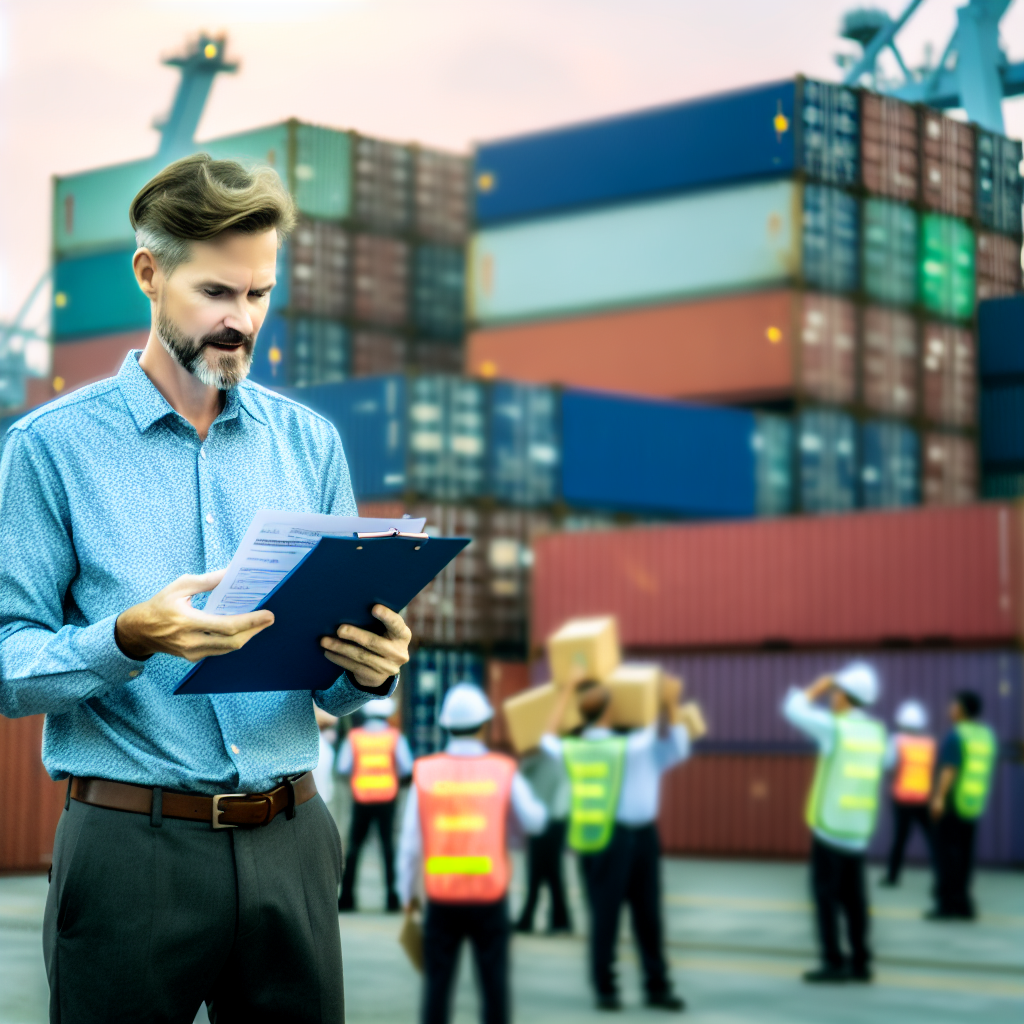Understanding Customs Procedures: An Overview for Freight Forwarders
The Importance of Customs Procedures
Customs procedures play a vital role in international trade.
They ensure that goods comply with local laws.
Furthermore, they help prevent illegal trade practices.
Key Terminology in Customs
Understanding key terms is essential for freight forwarders.
Customs broker refers to an agent for clearing goods.
Tariff classification denotes how goods are categorized.
Duties are taxes imposed on imported goods.
Moreover, a manifest is a document listing cargo details.
Customs Clearance Process
The customs clearance process involves several steps.
Initially, submit the required documentation.
This includes commercial invoices and packing lists.
Next, await customs inspection of the goods.
If compliant, customs will release the cargo.
Common Challenges
Freight forwarders often face various challenges.
Delays in documentation can occur frequently.
Additionally, misclassification leads to penalties.
Moreover, changes in regulations can complicate processes.
Best Practices for Managing Customs
Implementing best practices can streamline customs processes.
Maintain accurate records of all shipments.
Stay current on regulatory changes and compliance.
Furthermore, collaborate closely with customs brokers.
Key Documentation Required for Customs Clearance
Commercial Invoice
The commercial invoice is crucial for customs procedures.
It outlines the transaction between the buyer and seller.
This document must include a clear description of the goods.
Additionally, it should show the total value of the shipment.
Unlock Your Career Potential
Visualize a clear path to success with our tailored Career Consulting service. Personalized insights in just 1-3 days.
Get StartedPacking List
The packing list complements the commercial invoice.
It details the contents of each package in a shipment.
Shippers must provide accurate weights and dimensions.
This information aids customs officials in their assessments.
Bill of Lading
The bill of lading serves as proof of receipt of goods.
It is a contract between the shipper and the carrier.
Shippers should ensure it accurately reflects the goods transported.
Importantly, it must contain the specific delivery instructions.
Customs Declaration Form
The customs declaration form is essential for any shipment.
This document declares the contents and value of the shipment.
Shippers must complete it accurately to avoid customs delays.
Furthermore, every shipment requires a separate form.
Certificates and Permits
Some products require additional certificates or permits.
For example, food items often need health certificates.
Customs may ask for specific import licenses for certain goods.
It is vital to research requirements prior to shipping.
Export or Import License
Licenses can be necessary for regulated items.
The exporter or importer must obtain these licenses from relevant authorities.
Furthermore, failure to provide proper licensing can result in fines.
Every shipment’s documentation must comply with regulatory standards.
Common Customs Codes and Classifications in Freight Forwarding
Overview of Customs Codes
Customs codes play a vital role in international trade.
These codes assist in identifying goods for customs processing.
Understanding these classifications helps streamline logistics and compliance.
The Harmonized System
The Harmonized System (HS) is a globally recognized coding system.
It categorizes products in a systematic way for tariffs and trade statistics.
Over 200 countries use HS for customs purposes.
Each product gets an HS code that consists of six digits.
Importance of Accurate Classification
Accurate classification ensures appropriate duties are applied.
It prevents delays and potential fines during customs clearance.
Moreover, it enhances inventory control for importers and exporters.
On the other hand, incorrect codes can lead to costly errors.
Examples of Common Customs Codes
- HS Code 1001: Wheat and meslin.
- HS Code 0805: Citrus fruit, fresh or dried.
- HS Code 8703: Motor vehicles for transporting people.
- HS Code 4407: Wood sawn or chipped lengthwise.
How to Obtain Customs Codes
Companies can obtain customs codes through several methods.
First, they can consult the customs authority’s website.
Additionally, many trade organizations provide classification databases.
Furthermore, engaging a freight forwarder can ensure accuracy.
Changing Customs Codes
Customs codes may change based on updated regulations.
Freight forwarders must stay informed about any modifications.
Stable knowledge helps prevent misclassification.
Regular training sessions on customs procedures can enhance understanding.
Enforcement and Compliance
Governments enforce customs regulations strictly.
Compliance with these codes is essential for legal trading.
Customs audits can occur at any time, so readiness is critical.
Freight forwarders must maintain proper documentation throughout.
Explore Further: Exploring the Tools Maritime Pilots Use for Navigation
The Role of Tariffs and Duties in International Shipping
Understanding Tariffs
Tariffs are taxes imposed on imported goods.
They serve as a tool for regulating trade between countries.
Importers usually pay tariffs upon entering a country.
Tariffs can significantly affect shipping costs.
Additionally, they influence market competition.
Types of Tariffs
There are various types of tariffs that may apply.
Ad valorem tariffs are based on the value of goods.
Specific tariffs charge a fixed fee per unit of goods.
Compound tariffs combine both ad valorem and specific tariffs.
Understanding these types helps in effective cost estimation.
The Importance of Duties
Duties are fees levied on imported and exported goods.
They aim to protect local industries from foreign competition.
Duties can vary based on the product type and origin.
This variation makes it crucial for freight forwarders to assess duties accurately.
How Tariffs and Duties Impact Costs
The costs of tariffs and duties can accumulate swiftly.
These costs must be calculated when determining shipping expenses.
Moreover, they can affect pricing strategies for businesses.
In turn, this impacts how products compete in the market.
Navigating Tariffs and Duties
Understanding customs documentation is vital for compliance.
Moreover, accurate classification of goods is essential.
This classification determines applicable tariffs and duties.
Freight forwarders can assist in navigating these complexities.
Additionally, staying updated on tariff changes is crucial.
Countries periodically revise tariffs affecting international trade.
Best Practices for Freight Forwarders
Compliance with local customs regulations is paramount.
Freight forwarders should train their teams regularly.
Utilizing technology can streamline tariff and duty calculations.
Furthermore, establishing strong relationships with customs brokers is beneficial.
Lastly, thorough record-keeping helps in audits and reviews.
See Related Content: Skills Every Supply Chain Manager Should Master
Navigating Import and Export Regulations by Country
Understanding National Regulations
Each country has its own unique import and export regulations.
Conduct thorough research to understand these requirements.
This research helps avoid costly delays or penalties.
For example, the European Union enforces strict safety standards.
Similarly, the U.S. has its own compliance regulations.
Engaging with local experts can provide valuable insights.
Documentation Requirements
Documentation is critical in international shipping.
Each country mandates specific documentation for goods.
Common documents include invoices, bills of lading, and packing lists.
Some countries may require additional certificates, such as origin certificates.
Ensure that all documents are complete and accurate.
Inaccurate documentation can result in shipments being held up.
Duties and Taxes
Understanding duties and taxes is vital for budgeting.
Import duties vary significantly by product and country.
Research the Harmonized System codes for your goods.
This system helps determine applicable taxes and duties.
Consult with a freight forwarder to clarify these costs.
Unexpected taxes can impact your overall importation strategy.
Customs Clearance Process
The customs clearance process differs by country.
Some countries have streamlined processes, while others may be complex.
Be prepared to present all required documents at customs.
Customs agents may inspect shipments randomly.
Stay in touch with your shipping agent throughout this process.
Effective communication can facilitate smoother clearance.
Staying Updated on Changes
Trade regulations frequently change due to various factors.
Stay informed about updates that may affect your business.
Subscribing to trade news and joining relevant forums can help.
Networking with industry professionals also provides insights.
Use resources from government trade agencies for the latest information.
Remaining proactive helps mitigate compliance risks.
Find Out More: The Importance of Teamwork in Aviation Maintenance
Best Practices for Preparing Goods for Customs Inspection
Understanding Documentation Requirements
Proper documentation is essential for smooth customs inspections.
You must gather all necessary paperwork before shipment.
This includes invoices, packing lists, and import licenses.
Ensure that all documents align with the goods being shipped.
Inaccurate information can lead to delays or penalties.
Consult with legal experts to verify compliance.
Labeling and Packaging Correctly
Correct labeling is vital for facilitating inspections.
Use clear, legible labels on all packages.
Include essential details such as origin and destination addresses.
Consider adding barcodes or QR codes for quick processing.
Moreover, ensure your packaging meets international shipping standards.
Using robust materials prevents damage during transit.
Compliance with Customs Regulations
Stay updated on changing customs regulations.
Each country has unique rules regarding imports.
Research specific requirements based on the destination country.
Utilizing a customs broker can simplify this process.
They provide expertise in navigating complex regulations.
Conducting Pre-Inspection Checks
Consider conducting pre-inspection checks on your goods.
This practice helps identify potential issues beforehand.
Check for damage, discrepancies, or labeling errors.
Addressing these issues can prevent delays at customs.
Additionally, train staff to recognize common inspection triggers.
Communicating with Customs Officials
Open communication with customs officials is crucial.
Address any questions or concerns promptly and clearly.
Maintain a professional and cooperative attitude during inspections.
This approach can often expedite the process.
Be prepared to provide additional documentation if requested.
Staying Informed About Customs Procedures
Regularly educate yourself about customs procedures.
Read updates from customs authorities to stay compliant.
Attend training sessions or workshops when available.
Sharing knowledge among staff improves overall efficiency.
Consider subscribing to industry newsletters for timely information.
See Related Content: Certifications for Aspiring Aviation Maintenance Technicians

How to Handle Customs Delays and Non-Compliance Issues
Understanding Customs Delays
Customs delays can disrupt the flow of your freight operations.
They often occur due to incomplete documentation.
Additionally, inspections may take longer than expected.
In some cases, regulatory changes can cause unexpected delays.
Communicating with Customs Authorities
Effective communication is crucial during customs delays.
Always maintain contact with the customs office handling your shipment.
You can ask for updates to understand the status of your cargo.
It is important to provide any requested documentation promptly.
Dealing with Non-Compliance Issues
Non-compliance can lead to fines or shipment rejection.
First, identify the reason for the non-compliance notice.
Common issues include inaccurate declarations or missing licenses.
Next, address these issues as quickly as possible.
Steps to Rectify Non-Compliance
Gather all relevant documents related to the shipment.
Review customs requirements specific to your shipment’s category.
Once you understand the requirements, correct any inaccuracies.
Then, resubmit your documentation to customs.
Mitigating Future Risks
Preventing future customs delays requires proactive measures.
Ensure your documentation is thorough and accurate before shipping.
Moreover, stay informed about any changes in customs regulations.
Consider using customs brokerage services for expert assistance.
Utilizing Technology for Efficiency
Technology can significantly improve customs compliance processes.
Use software solutions to track and manage shipments.
Digital tools can also help maintain accurate records easily.
Regularly update your database with changing customs regulations.
Building Relationships with Customs Authorities and Agents
Understanding the Importance of Relationships
Building solid relationships with customs authorities is essential for smooth operations.
These relationships facilitate faster clearance processes and reduce delays.
When agents know you well, they may offer valuable insights and advice.
Additionally, personal connections foster trust and transparency in communications.
Establishing Trust with Customs Officials
Honesty is crucial when dealing with customs officials.
Provide accurate information and documentation to avoid complications.
Respond timely to inquiries, as this shows reliability.
Moreover, treating officials with respect can enhance mutual trust.
Networking Opportunities
Participating in industry events can expand your network with customs agents.
Conferences and trade shows allow you to meet key players in person.
Follow up with contacts after events to solidify relationships.
Join trade associations related to logistics and customs for further networking.
Engaging in Continuous Education
Stay informed about customs regulations and procedures through training.
Attend workshops or webinars hosted by customs authorities.
Such education helps you understand officials’ perspectives and challenges.
Additionally, it demonstrates your commitment to compliance and professionalism.
Maintaining Open Lines of Communication
Regular communication fosters stronger relationships with customs agents.
Be proactive in seeking feedback on customs procedures and requirements.
Share pertinent updates from your side, including changes in business practices.
Utilize various communication channels to keep in touch effectively.
Utilizing Third-party Customs Brokers
Consider engaging third-party customs brokers to navigate complex regulations.
These brokers build connections with customs authorities on behalf of clients.
They often have established relationships that can expedite processes.
Choose experienced brokers to ensure compliance and efficiency in shipping.
Regularly Reviewing Procedures and Relationships
Schedule regular reviews of your customs-related processes and relationships.
Evaluate how your interactions with customs authorities can improve over time.
Adapt your strategies to changing regulations and instructions from authorities.
Continuous improvement will lead to more streamlined operations.
Utilizing Technology and Software for Efficient Customs Management
The Role of Technology in Customs Management
Technology plays a crucial role in streamlining customs operations.
It enhances communication between freight forwarders and customs authorities.
This technology ensures accurate documentation and compliance.
Therefore, investing in the right tools can save time and costs.
Customs Management Software Solutions
Customs management software automates many tedious processes.
These solutions help with tracking shipments and managing documentation.
For instance, software like Descartes and Amber Road can simplify procedures.
Additionally, they offer real-time updates which improve decision-making.
The Importance of Data Accuracy
Accurate data entry is vital for smooth customs operations.
Any errors can lead to significant delays and increased costs.
Thus, using automated systems reduces human error significantly.
This results in faster processing times and improved efficiency.
Implementing EDI for Seamless Transactions
Electronic Data Interchange (EDI) facilitates quicker transactions.
It allows the exchange of documents without manual input.
Consequently, EDI improves overall compliance with customs regulations.
It further enhances collaboration between stakeholders in the supply chain.
Leveraging AI and Machine Learning
Artificial Intelligence (AI) and Machine Learning (ML) can optimize customs processes.
These technologies analyze large datasets to identify trends and discrepancies.
Moreover, they can predict potential customs issues before they arise.
This proactive approach prevents delays and fines.
Integrating Blockchain for Transparency
Blockchain technology offers greater transparency in customs management.
This technology creates an immutable record of all transactions.
As a result, it builds trust among stakeholders throughout the supply chain.
Furthermore, it enhances security and reduces the risk of fraud.
Training Staff on Technology Use
Effective implementation of technology requires proper staff training.
Training ensures that employees are proficient with new systems.
Regular workshops and updates keep the team knowledgeable about innovations.
Ultimately, well-trained staff can fully leverage technology’s potential.




